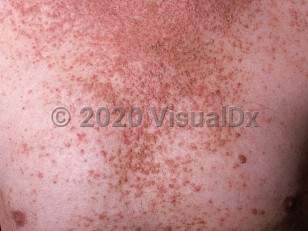Darier disease in Adult
See also in: Anogenital,Nail and Distal DigitAlerts and Notices
Important News & Links
Synopsis

Darier disease, also known as keratosis follicularis or Darier-White disease, is an autosomal dominantly inherited disease caused by mutations in the ATP2A2 gene, which encodes a sarco / endoplasmic reticulum calcium-ATPase pump (SERCA2). Although disease penetrance is high, expression is variable, and sporadic mutations may occur. There is no sex predilection.
Darier disease presents in early adolescence to mid-adult life, with peak onset in the second decade of life. The disease manifests with greasy, hyperkeratotic papules in a seborrheic distribution, along with palmoplantar pits, acrokeratosis verruciformis-like papules, and characteristic nail findings ("candy-cane" nails with V-shaped notch at the free edge). Leukodermic macules are a rarely reported finding. These small macules occur most frequently on the ventral aspect of limbs and the trunk. Their onset is prior to puberty. They have been recognized and reported most frequently in individuals with darker skin colors.
In addition to cutaneous findings, 15%-50% of patients present with oral involvement, including cobblestoning of the oral mucosa, gingival hypertrophy, and sialadenitis. Esophageal involvement with erosions has been described. The severity of oral disease may parallel that of cutaneous disease.
After onset, the disease is lifelong. It may be accentuated or only prominent in the spring and summer, when exposures to heat, perspiration, and ultraviolet (UV) light are increased. Other exacerbating conditions / factors may include trauma, menstruation, and certain drugs (eg, lithium, oral corticosteroids).
The lesions of Darier disease may be pruritic, painful, or malodorous. These symptoms, along with the appearance of the lesions, may lead to significant psychosocial distress. Patients are also at an increased risk of bacterial or viral skin infections.
Linear, segmental, or unilateral presentations are uncommon variants of the disease caused by mutations in the same gene.
Darier disease presents in early adolescence to mid-adult life, with peak onset in the second decade of life. The disease manifests with greasy, hyperkeratotic papules in a seborrheic distribution, along with palmoplantar pits, acrokeratosis verruciformis-like papules, and characteristic nail findings ("candy-cane" nails with V-shaped notch at the free edge). Leukodermic macules are a rarely reported finding. These small macules occur most frequently on the ventral aspect of limbs and the trunk. Their onset is prior to puberty. They have been recognized and reported most frequently in individuals with darker skin colors.
In addition to cutaneous findings, 15%-50% of patients present with oral involvement, including cobblestoning of the oral mucosa, gingival hypertrophy, and sialadenitis. Esophageal involvement with erosions has been described. The severity of oral disease may parallel that of cutaneous disease.
After onset, the disease is lifelong. It may be accentuated or only prominent in the spring and summer, when exposures to heat, perspiration, and ultraviolet (UV) light are increased. Other exacerbating conditions / factors may include trauma, menstruation, and certain drugs (eg, lithium, oral corticosteroids).
The lesions of Darier disease may be pruritic, painful, or malodorous. These symptoms, along with the appearance of the lesions, may lead to significant psychosocial distress. Patients are also at an increased risk of bacterial or viral skin infections.
Linear, segmental, or unilateral presentations are uncommon variants of the disease caused by mutations in the same gene.
Codes
ICD10CM:
Q82.8 – Other specified congenital malformations of skin
SNOMEDCT:
48611009 – Darier's disease
Q82.8 – Other specified congenital malformations of skin
SNOMEDCT:
48611009 – Darier's disease
Look For
Subscription Required
Diagnostic Pearls
Subscription Required
Differential Diagnosis & Pitfalls

To perform a comparison, select diagnoses from the classic differential
Subscription Required
Best Tests
Subscription Required
Management Pearls
Subscription Required
Therapy
Subscription Required
References
Subscription Required
Last Reviewed:09/12/2023
Last Updated:09/21/2023
Last Updated:09/21/2023
Darier disease in Adult
See also in: Anogenital,Nail and Distal Digit

